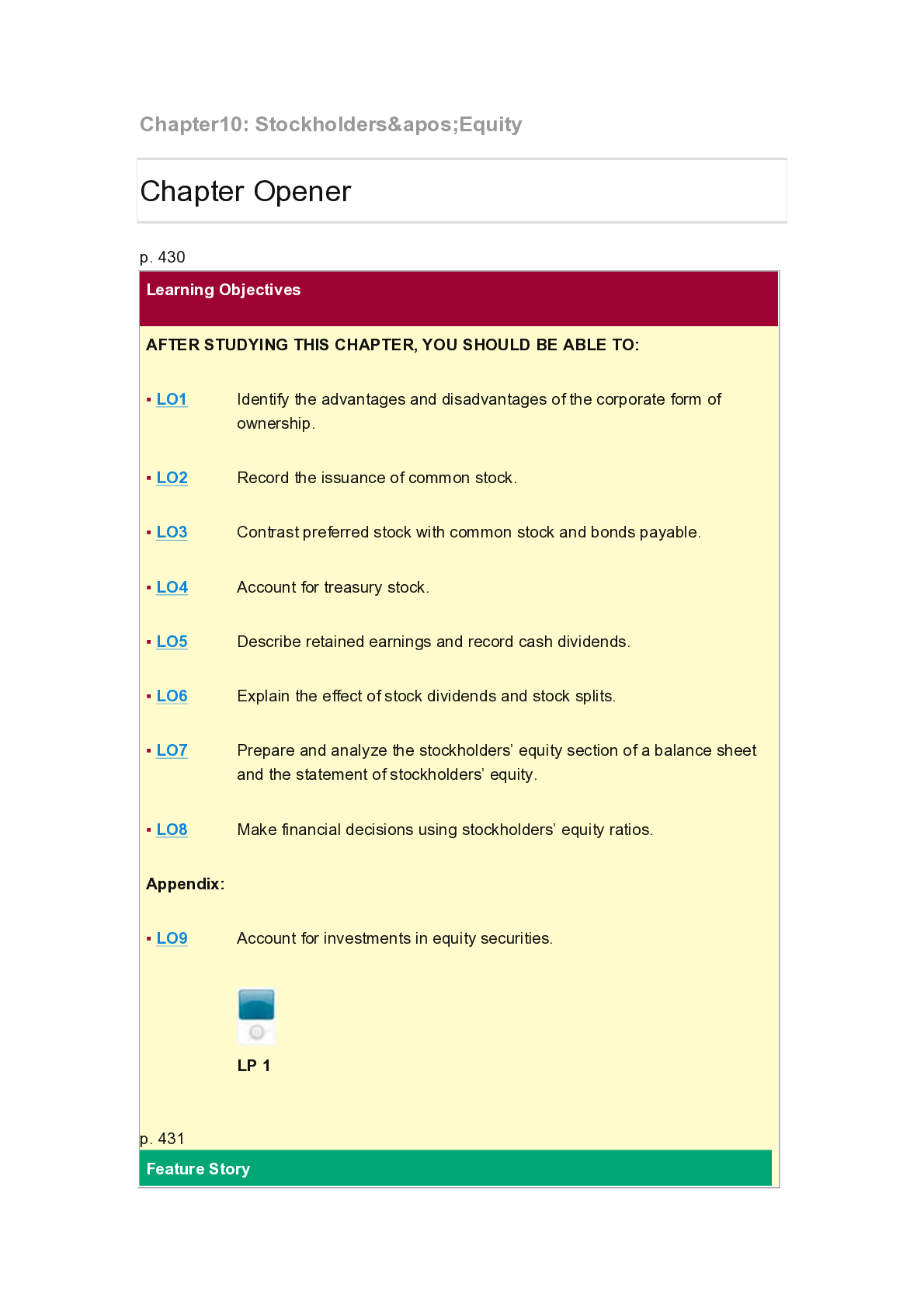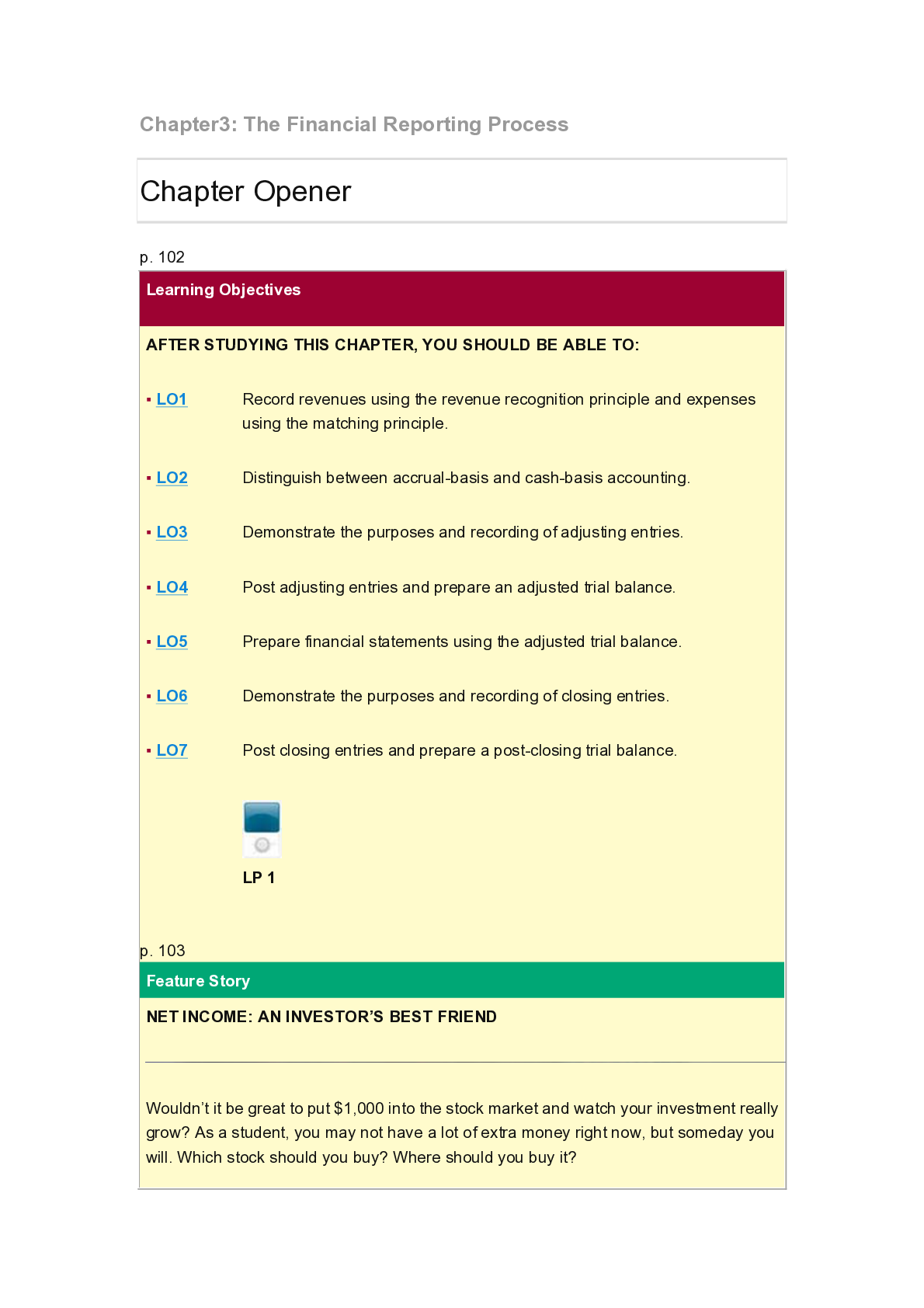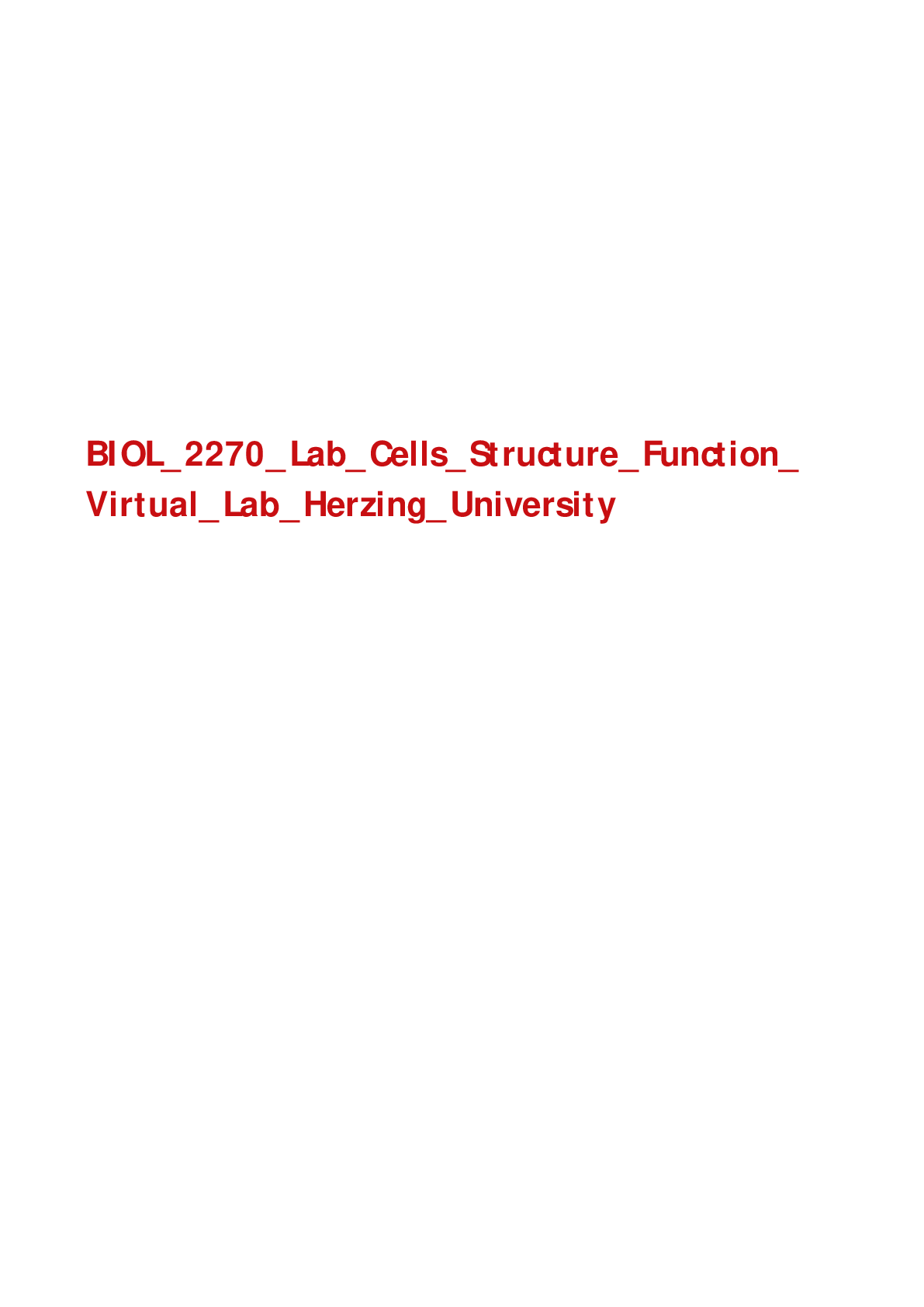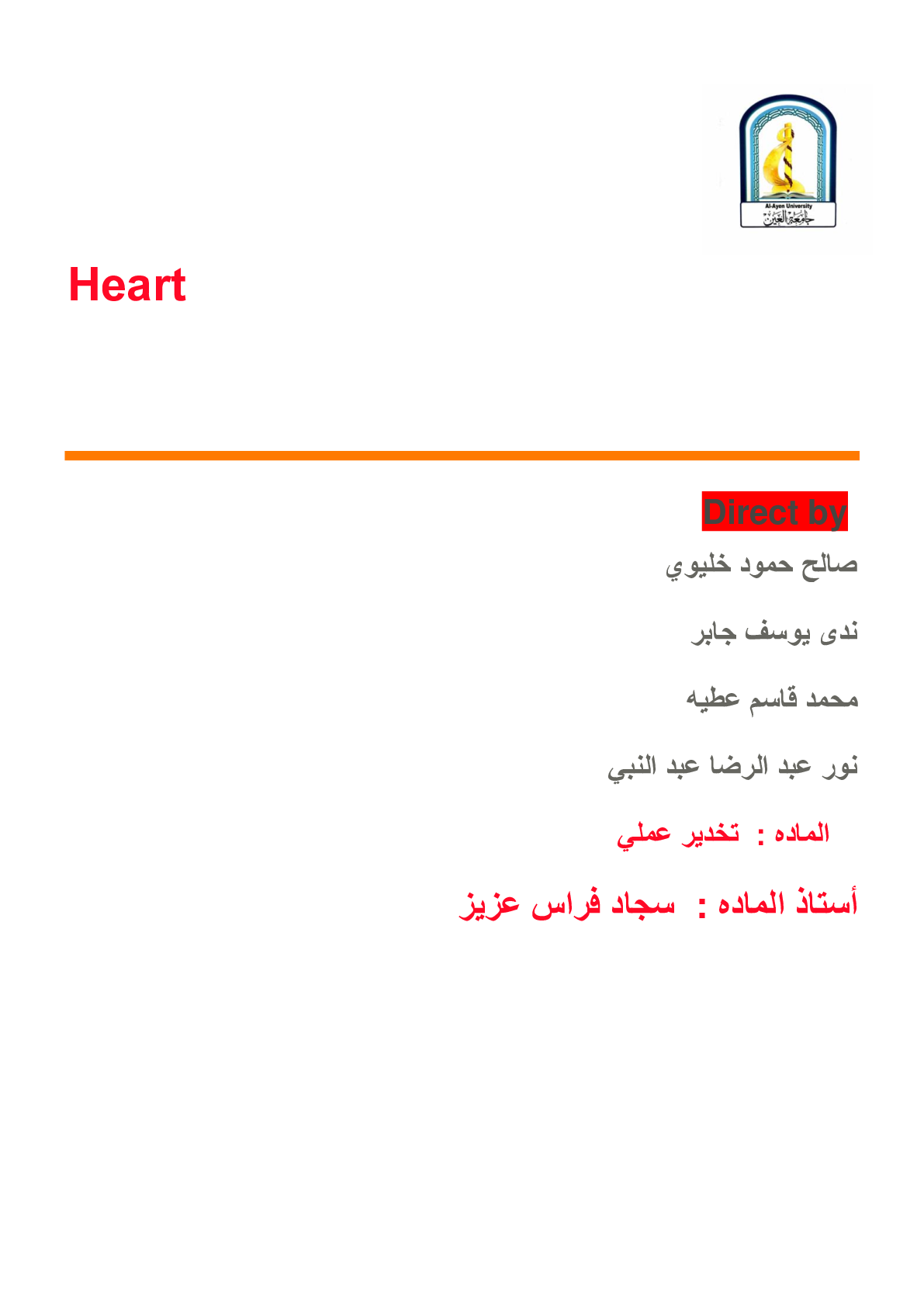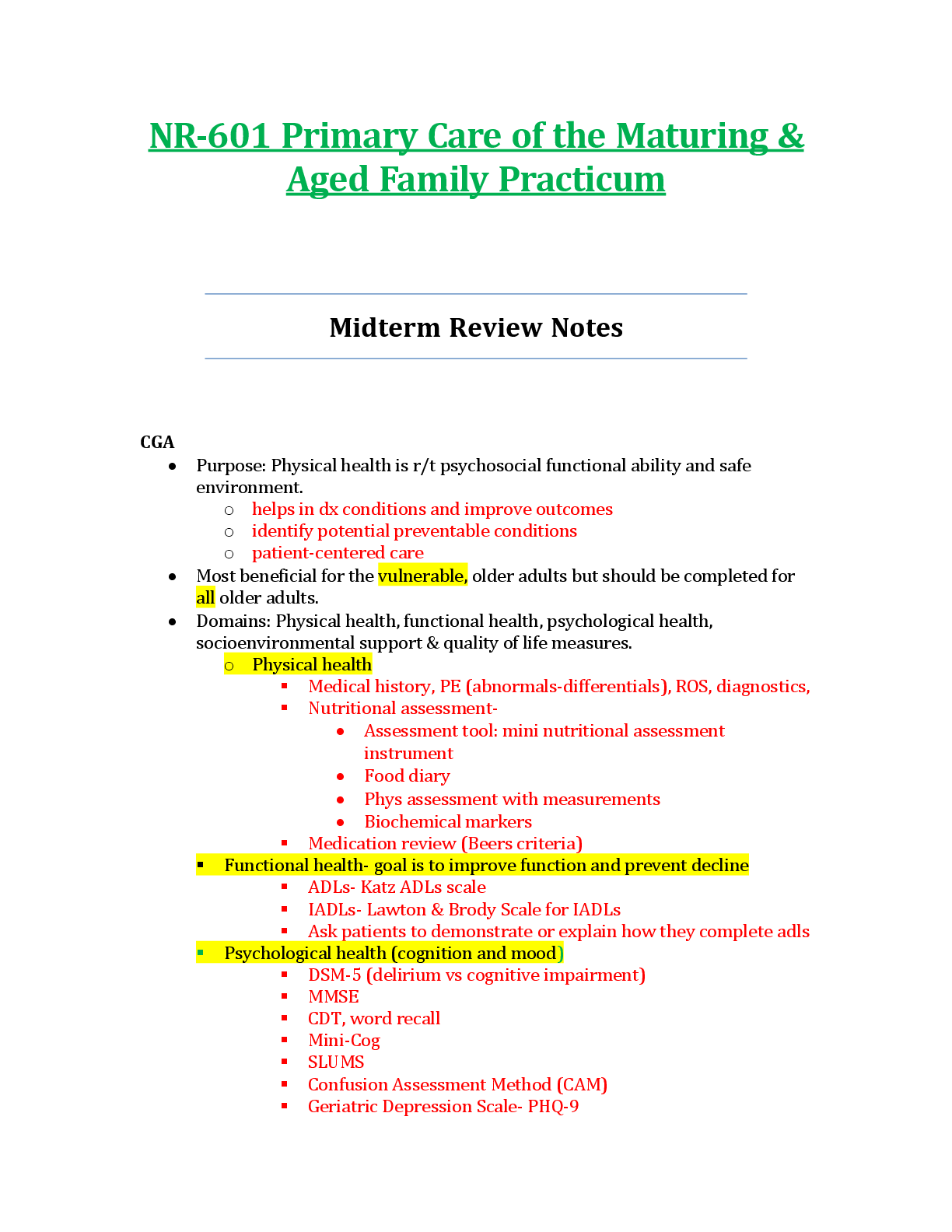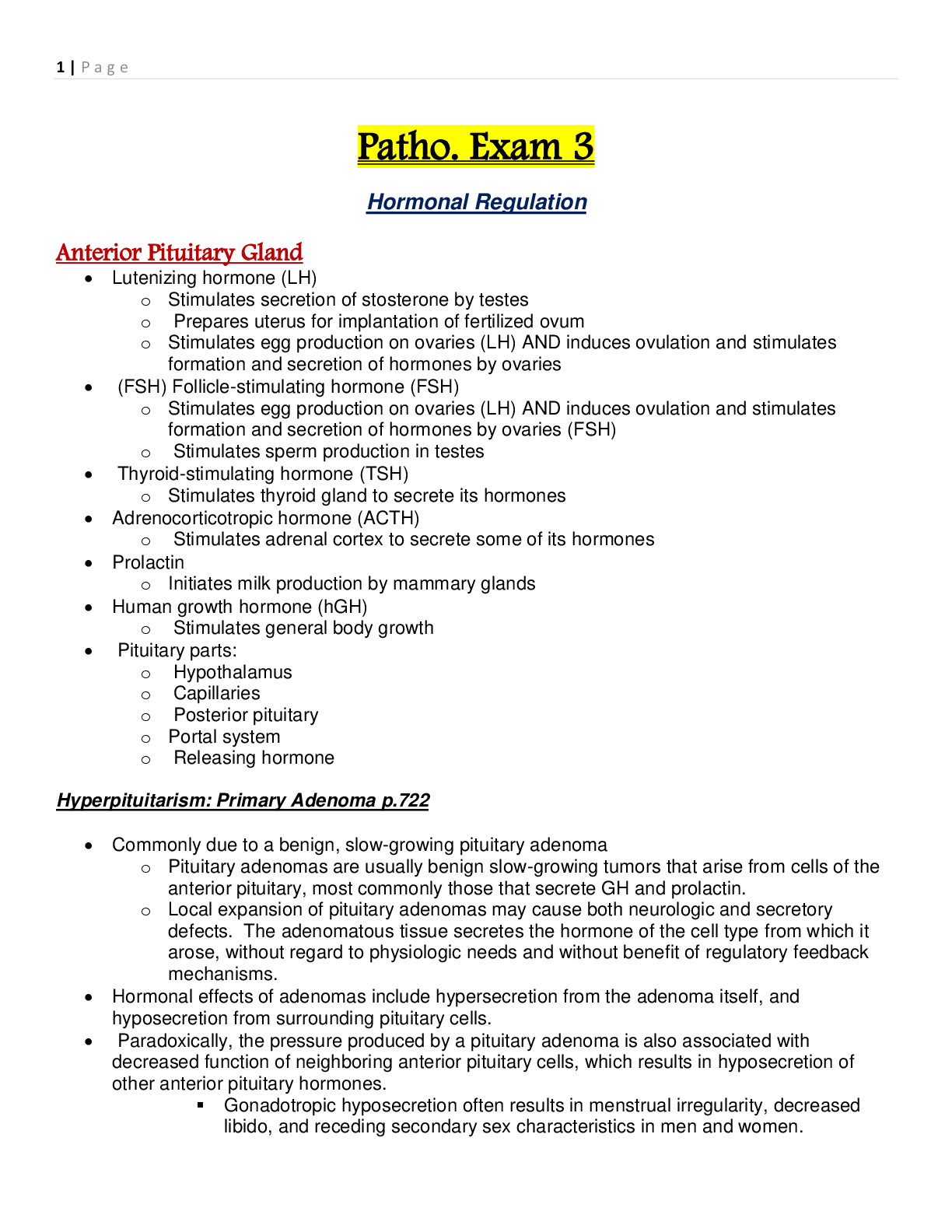Chemistry > Study Notes > University of Texas, Dallas - BIOL 3380lab 4 Best lecture notes (All)
University of Texas, Dallas - BIOL 3380lab 4 Best lecture notes
Document Content and Description Below
The Big Picture Experiment 4 – Purification of rGFP using Ni+2 Agarose 1. Broad process of protein purification 2. Class demo on separation principles 3. Two common column chromatography systems ... – gel filtration affinity chromatography BIOL3380-Spring 2015 By Jumping Gene at Clontech Laboratories, Inc. “For Research Use Only” | March 2012 Experiments #3-8 The overall goal/purpose of theses series of experiments is to see if we can express and a recombinant form of GFP (rGFP) from the E. coli strain BL21(DE3)<pLysS><pRSETA-GFPUV> using the chromatography technology. Leaky also called IMAC technology: expression BIOL3380-Spring 2015 By Jumping Gene at Clontech Laboratories, Inc. Leaky expression | May 2012 “immobilized metal affinity chromatography” Express rGFP in E. coli Grow the E. coli and induce (turn on) the expression (transcription/translation) of rGFP Grow 3 hours Harvest 15ml centrifuge decant supernatant BIOL3380-Spring 2015 Induce expression with IPTG G0 = G culture before induction G3 = G culture 3 hours post induction G3-15ml pellet isolate a crude extract purify His6 tagged proteins Experiment #4 Purification of rGFP using Ni+2 agarose Develop column with a wash buffer followed by an elution buffer BIOL3380-Spring 2015 Collect and store samples for further analysis GCE = rGFP Crude Extract W = wash fraction E = elution fraction Experiment #5 Determining Protein concentration of rGFP fractions W1-W6 Bradford Assay Estimate protein amount in each fraction. Knowing volume BIOL3380-Spring 2015 E1-E6 calculate protein concentration Experiment #6 SDS-PAGE/Coomassie Blue analysis of rGFP fractions Purpose Estimate protein purity and relative MW G0 G3 BIOL3380-Spring 2015 GCE W2-W3 E2-E3 coomassie blue staining Experiment #7/8 SDS-PAGE/Western Transfer and Western Blot G0 G3 Purpose Confirm the presence of rGFP using specific antibodies BIOL3380-Spring 2015 GCE W2-W3 E2-E3 transfer to nitrocellulose probe and detect Four intellectual steps to optimize protein purification 1. Development of a suitable assay procedure Qualitative- Hand-held UV light “low, medium, high fluorescence” λ ex 395nm λem 510nm rGFP BIOL3380-Spring 2015 Quantitative – Spectrofluorometer – “100 RFU versus 5000 RFU” 2. Selection of the 3. Solubilization of the desired protein 4. Development of a suitable series of Primary tissue Tissue culture (in situ) Yeast expression system Selection of the Best Source Material BIOL3380-Spring 2015 Bacterial expression system In vitro expression system Advantages Inexpensive Minor space/equipment requirements Large yields Control of Expression “The New Starting Point for Biochemists” Yeast/Bacterial Expression Systems Disadvantages Stability/solubility BIOL3380-Spring 2015 Purification method Grinding in mortar/pestle or tissue grinder Grinding in blender with sand or glass beads High pressure – “French Press” Sound waves – “sonication” Freeze thaw with liquid nitrogen Lysozyme added to breaking buffer Broad Process of Protein Purification Prepare a crude extract BIOL3380-Spring 2015 Decrease extract volume using (NH4)2SO4 (also removes nucleic acids) Dialysis to remove small molecules and (NH4)2SO4 Several Column Chromatography steps Ion exchange > Affinity column > Gel filtration Storage – usually -70oC in a buffer that contains glycerol P lac T7 RNA Polymerase Lac repressor (protein) His6-Xpress-GFPUV BL21(DE3)<pLysS> <pRSETA-GFPUV> T7 RNA Polymerase (protein) 3 hours Post-induction “G3” sample IPTG induction rGFP lacI Bacterial Chromosome Bacterial cell wall and membrane pRSETA-GFPuv pLysS lysozyme Lysozyme (protein) AmpR CamR BIOL3380-Spring 2015 quickly thaw, cells with damaged walls burst open because of osmotic shock. lysozyme degrades neighboring cell walls Slow Freeze/Quick Thaw method of cell lysis using pLysS technology slowly freeze cells, ice crystals form inside cells, some cell walls are punctured BIOL3380-Spring 2015 chain reaction of lysing begins notice: not 100% efficient Visual representation of cell lysis Underlying principle behind any purification step Exploiting the interest and all other molecules. between your molecule of Chromatography separates molecules based upon the differential interaction with both a phase and a phase. (note: for our purposes substitute the word “molecule” with “protein”) BIOL3380-Spring 2015 Exploit differences in: size shape charge hydrophobicity – the removal of other proteins. Usually expressed as a percentage – the amount of either total protein or your protein of interest. Expressed as an amount (ug, mg, etc.) or a percentage. Three concepts you need to consider/balance during fractionation steps of protein purification BIOL3380-Spring 2015 – the function of your protein of interest Total Protein Amount Amount % Purity Crude Extract After 1st Fractionation After 2nd Fractionation After 3rd Fractionation Target Protein BIOL3380-Spring 2015 (activity/total protein amount) During protein purification schemes… TYPICALLY: Yield Purity Activity Specific Activity BIOL3380-Spring 2015 Common Types of Chromatography based on Gel Filtration (size exclusion) Ion-exchangers Anion exchanger Cation exchanger Affinity Chromatography BIOL3380-Spring 2015 Partition chromatography Hydrophobic Interaction Chromatography difference in hydrophobic properties polarity or water solubility BIOL3380-Spring 2015 Principle of separation using Gel Filtration (Size-exclusion) Chromatography BIOL3380-Spring 2015 BIOL3380-Spring 2015 Common Types of Chromatography based on Gel Filtration (size exclusion) specific separation principle Ion-exchangers Anion exchanger Cation exchanger Charge – Charge interactions Affinity Chromatography BIOL3380-Spring 2015 Partition chromatography Hydrophobic Interaction Chromatography difference in hydrophobic properties polarity or water solubility Ni+2-Agrarose Affinity Chromatography (Patented and sold by “Qiagen”) BIOL3380-Spring 2015 inert matrix chemical linker 6 consecutive histidines are more efficient than 2 histidines C-terminus BIOL3380-Spring 2015 in binding to the column N-terminus Eluting His6 tagged proteins off a Ni+2 column Change in buffer pH alters histidine charge – no longer binds column BIOL3380-Spring 2015 Let’s look at flow diagram for this week’s experiment Express rGFP in E. coli BIOL3380-Spring 2015 Purify rGFP using Ni+2 column Inoculate 10ml media with single colony Inoculate 500ml media Agar plate with colonies of BL21(DE3)<pLysS><pRSETA-GFPUV> Harvest 1ml pellets for Labs #6 and #7 G0 G3 Harvest 15ml for Lab #4 Grow overnight 37oC Grow 3 hours OD 600nm = 0.1 OD600nm = 0.5 Grow 37oC Induce expression with IPTG BIOL3380-Spring 2015 discard LB supernatant 15ml of G3 culture centrifuge G3-15ml Pellet Decant transfer to 1.5ml tube pellet in 1ml centrifuge buffer Collect/Save Add Wash buffer Add Elution buffer Collect/Save Collect/Save BIOL3380-Spring 2015 It has come to our attention that some students are attending lecture without printouts of the lecture notes. Please be aware that not having printouts will put you at a disadvantage for clicker BIOL3380-Spring 2015 questions in future lectures. We HIGHLY recommend 2 slides per page! The Week in Review Experiment 4 – Purification of rGFP using Ni+2 Agarose Prepare a crude extract from the bacterial strain: BL21(DE3)<pLysS><pRSETA-GFPUV> Prepare and load a Ni+2 agarose column with the crude extract. The Be Able To’s Experiment 4 – Purification of rGFP using Ni+2 Agarose 1. What is the underlying principle that allows for the purification of rGFP? 2. Why does freezing and then thawing the bacterial pellet result in lysis? 3. What is the purpose of the “wash” step when developing the column? 4. How are we monitoring the presence of rGFP? BIOL3380-Spring 2015 5. If we were purifying a histidine tagged phosphatase, how would we monitor its presence during the purification procedure? 6. What is the underlying principle that allows for the elution of rGFP from the Ni+2-agarose column? 7. What are the five major types of column chromatography and the underlying scientific principles that make them useful for separating proteins? [Show More]
Last updated: 3 years ago
Preview 1 out of 31 pages

Buy this document to get the full access instantly
Instant Download Access after purchase
Buy NowInstant download
We Accept:

Reviews( 0 )
$6.00
Can't find what you want? Try our AI powered Search
Document information
Connected school, study & course
About the document
Uploaded On
May 27, 2020
Number of pages
31
Written in
All
Additional information
This document has been written for:
Uploaded
May 27, 2020
Downloads
0
Views
244







